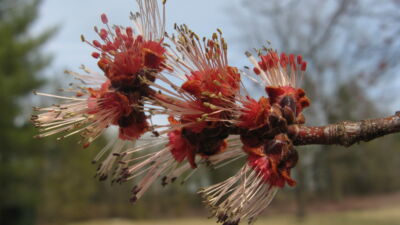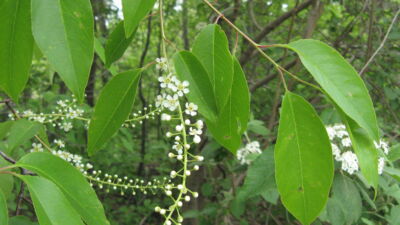Tree flowering time is here!
Spring is here and that means flowering season for most of our native trees and shrubs. While all trees and shrubs produce flowers with male and female parts, not all produce showy blossoms with petals and sepals that catch our eyes. Some species hold their male and female parts in the same flower (called perfect flowers), others have their male parts (pollen flowers) and female parts (seed flowers) on different trees (e.g., ashes and willows) or different parts of the same tree (e.g., oaks and birches).
Generally, plants are either insect pollinated or wind pollinated.
Wind pollinated trees such as maples, oaks, poplars and willows do not produce showy flowers, but instead produce a lot of lightweight pollen (from the male stamens) that gets carried in the air currents to other tree flowers of the same species. These trees trade off the expense of developing methods to attract pollinators such as petals, nectar and scents, and invest in producing large quantities of pollen.

Silver maple is wind pollinated and has pollen flowers (shown) on separate trees or separate branches of the same trees as the female flowers.
Insect-pollinated trees and shrubs such as dogwoods, tulip tree, cherries, and hawthorns, use colourful or fragrant flowers to attract insects to them. In return, the pollinators (i.e., bees, flies, butterflies, beetles and so on) may get tasty nectar or nutritious pollen to eat. In the process, they get sticky pollen stuck to them, which they carry to the next blossom of the same species for pollination.

Black cherry flowers are insect pollinated.
If fertilization occurs in the pollinated flowers, seeds or nuts will develop. By late summer or fall, the mature seeds or nuts are ready to be transported by wind, water or animals to new territories. Many will be eaten by wildlife or land on inhospitable ground, but some will sprout to produce a new tree.
2023 was a heavy pollen year, and many people recall seeing a coating of yellow pollen on their cars, outside furniture, and windowsills. Allergy sufferers may remember it well. In this region, the trees most commonly associated with allergies are oak, maple and birch. Other trees that can cause seasonal allergies include ash, aspen, beech, Manitoba maple, pine, cedar, cottonwood, elm, hickory, and willow. Luckily, the flowering season lasts only a few weeks for each species and we can enjoy the trees’ many benefits for the remainder of the year!
Contact: Cathy Quinlan, Terrestrial Biologist

